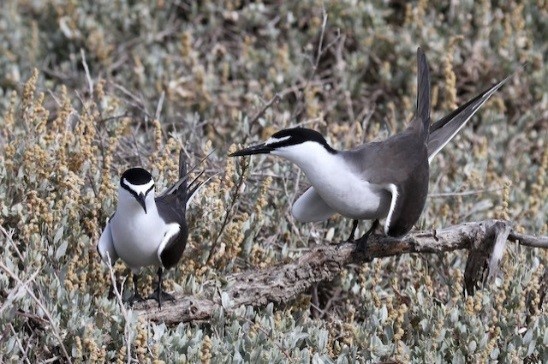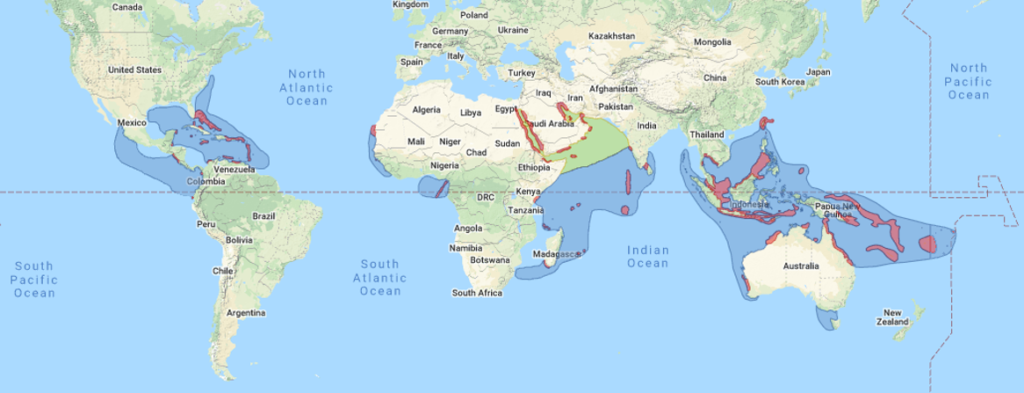Birdfinding.info ⇒ Locally common in its principal breeding areas: along the eastern rim of the West Indies from the Bahamas to the Lesser Antilles; all around the Arabian Peninsula; and across a broad swath of the Indo-Pacific from southern Thailand and Taiwan to Western Australia, Queensland, and western Polynesia. In the U.S. it is fairly common from May to October in the Gulf Stream north to Hatteras, and a few pairs are usually present at the Dry Tortugas from April to July.
Bridled Tern
Onychoprion anaethetus
Pantropical. Largely pelagic when not breeding.
Breeding. Breeds colonially on tropical oceanic islets. The regional populations are usually treated as four subspecies: Atlantic, western Indian, Indo-Pacific, and eastern Pacific.
Atlantic: melanopterus breeds throughout the Caribbean region, on islands off of western Africa (Mauritania and Senegal) and in the Gulf of Guinea. The Caribbean population is estimated at about 10,000 pairs breeding at over 200 sites from Arrecife Alacranes (north of the Yucatán Peninsula) and the Dry Tortugas to Aruba and Tobago, much more numerous and widespread eastward: in the Bahamas, Turks & Caicos, Puerto Rico, Virgin Islands, Leeward Islands, and Lesser Antilles. Has bred occasionally in the Azores.
Western Indian: antarcticus breeds on islets in the Red Sea, Persian Gulf, and on several island groups of the western Indian Ocean south to Madagascar, Mauritius, and Réunion, and east to Sri Lanka and the Cocos Keeling Islands.
Indo-Pacific: anaethetus is the most widespread, breeding from south-coastal China (Fujian) and Japan’s Yaeyema Islands south through the Philippines, Palau, and Indonesia to the eastern Indian Ocean (to southwestern Australia) and in the Pacific to Queensland, New Caledonia, and western Polynesia (east to American Samoa).
Eastern Pacific: nelsoni breeds on a few scattered islets from Nayarit, Mexico south to Ecuador, with the majority in the Gulf of Fonseca and Costa Rica.
Movements. Most populations are thought to disperse to offshore waters within the general region where they breed. The extent of this dispersal is not well understood and certainly varies from one region to another.
From May to October, a significant portion of Caribbean population—including nonbreeders, post-breeding adults, and juveniles—moves into the Gulf of Mexico and the Atlantic Gulf Stream waters from Florida to North Carolina.
Hurricanes sometimes transport dozens of Bridled Terns north to New England and inland across the eastern U.S. (to Arkansas and Tennessee). Under normal conditions, a few regularly wander north along the Eastern Seaboard as far as southern New England, exceptionally to Nova Scotia. Along the Pacific coast of North America, wanderers have reached southern California.
Vagrants have strayed to many parts of the world, with several records from western Europe (north to the Shetland Islands), East Asia (north to Honshu), southern Africa, and the mid-Pacific (to Hawaii and the Gambier Islands).
Identification
A mostly pelagic, dark-backed tern that habitually rests on flotsam at sea. This habit appears to be consistent throughout its range and is often a useful clue in identification.
Breeding adults are dark-gray above, all-white below, with a black cap, white forehead and thin white eyebrows—in the shape of a narrow visor. The upper back shades to paler gray, palest at the base of the neck, forming a pale-gray or white collar that contrasts sharply with the border of its black cap.
In flight, from below, the wings typically appear mostly white, framed with a broad dark gray or blackish trailing edge and leading edge on the outermost primaries.

Bridled Tern, O. a. anaethetus, resting on marine debris, typical of Bridled Terns worldwide. (Offshore from Po Toi, Hong Kong; May 24, 2008.) © Martin Hale
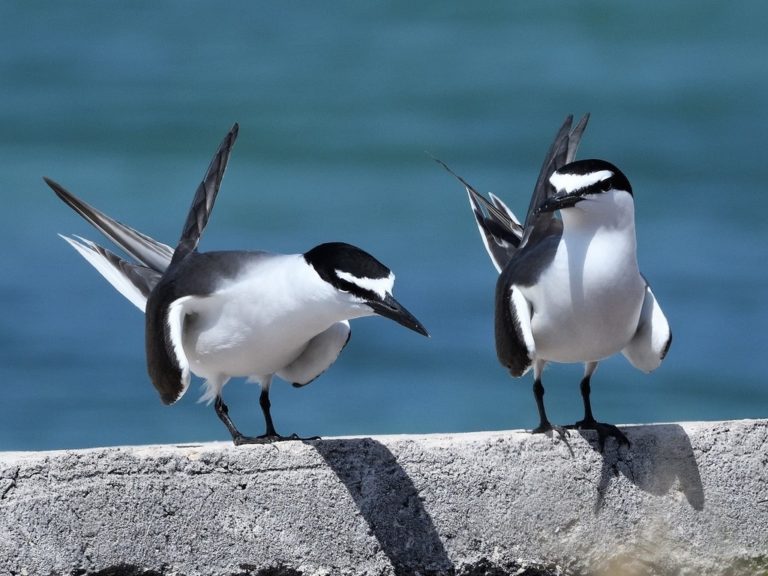
Bridled Tern, O. a. melanopterus. (Garden Key, Dry Tortugas National Park, Florida; April 30, 2019.) © Doug Clarke
Geographical Variation. The subspecies vary somewhat in coloration and pattern—each varies internally and their tendencies differ to some extent. The most consistent distinction seems to be in the tail: melanopterus generally has more extensively white outer tail feathers, a difference that is evident mainly in flight when viewed dorsally.
The western and central Indian Ocean subspecies, antarcticus, seems to have darker upperparts and more extensively blackish underwings, at least on average.
Both antarcticus and the Atlantic subspecies, melanopterus, typically show a white collar between the black crown and gray back, whereas the Indo-Pacific anaethetus usually has a gray collar—paler than the back, but not white.
In most if not all of these features, however, the variation within each subspecies seems to exceed the differences among them.

Bridled Tern, O. a. antarcticus, showing a broad, white collar. (Taleimannar, Sri Lanka; June 3, 2016.) © Mapalagama K. Premasiri

Bridled Tern, O. a. melanoptera, showing a broad white collar. (Garden Key, Dry Tortugas National Park, Florida; June 15, 2017.) © Qianwen Rockoff
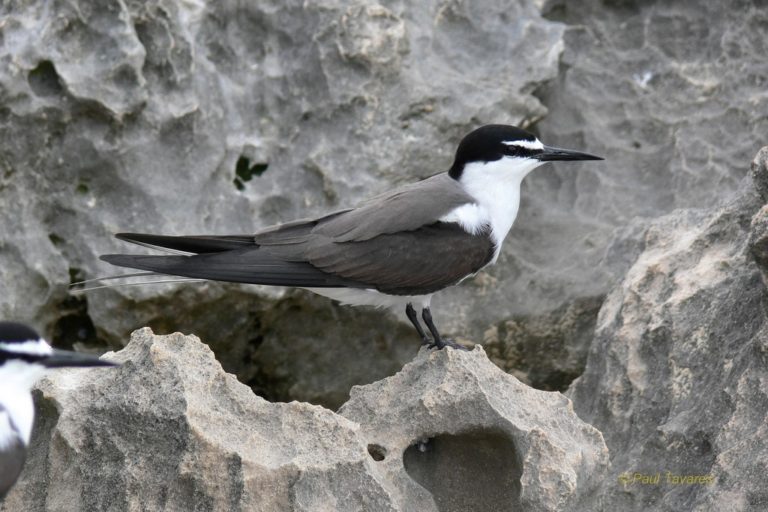
Bridled Tern, O. a. anaethetus. (Rockingham, Western Australia; January 14, 2006.) © Paul Tavares

Bridled Tern, O. a. anaethetus, showing mostly dark-gray upper back in this view. (Lady Elliot Island, Queensland, Australia; February 4, 2016.) © Ray Turnbull
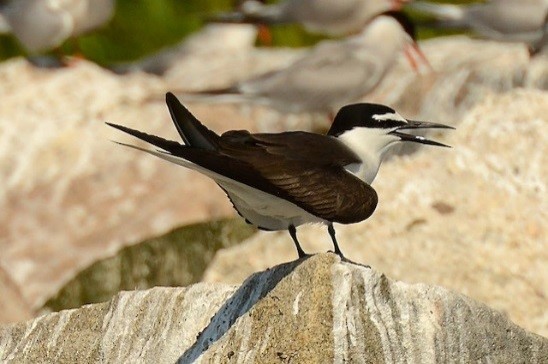
Bridled Tern, O. a. melanopterus, with upperparts appearing mostly blackish in this view, essentially indistinguishable from Sooty Tern, except for its long, thin eyebrow. (Falkner Island, Connecticut; August 1, 2017.) © Stephen Broker

Bridled Tern, O. a. anaethetus, showing narrow white brow-stripe. (Ko Tao, Surat Thani, Thailand; July 9, 2019.) © Ayuwat Jearwattanakanok

Bridled Tern, O. a. melanopterus. (Peterson Cay National Park, Grand Bahama; June 9, 2019.) © Martha Cartwright

Bridled Tern, O. a. anaethetus, showing a facial expression that is both quizzical and angry. (Xiao Yangshan Island, Zhejiang, China; June 7, 2020.) © Cheng Qian

Bridled Tern, O. a. melanopterus. (Garden Key, Dry Tortugas National Park, Florida; May 5, 2019.) © Homer Gardin

Bridled Tern, O. a. antarcticus. (Umm Al-Maradim Island, Al Ahmadi, Kuwait; April 9, 2017.) © Paul Chapman

Bridled Tern, O. a. anaethetus, with upperparts appearing somewhat brownish in this view. (Penguin Island, Rockingham, Western Australia; February 7, 2017.) © James Kennerley

Bridled Tern, O. a. anaethetus. (Penguin Island, Rockingham, Western Australia; April 12, 2015.) © Shelley Altman
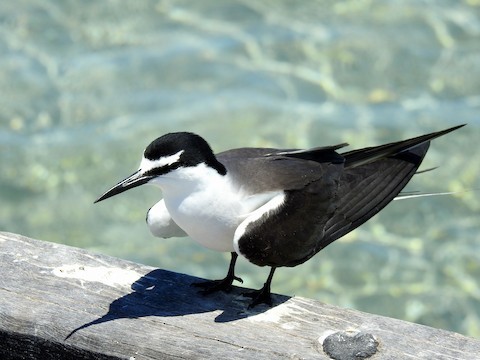
Bridled Tern, O. a. anaethetus, with upperparts appearing mostly blackish in this view. (Penguin Island, Rockingham, Western Australia; December 7, 2017.) © Greg Blackman
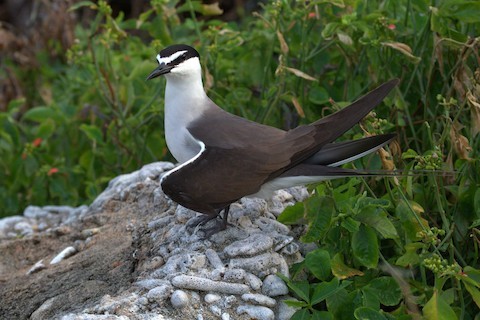
Bridled Tern, O. a. anaethetus. (Lady Elliot Island, Queensland, Australia; December 4, 2010.) © Mat Gilfedder
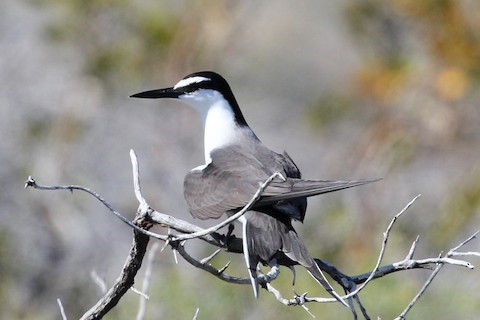
Bridled Tern, O. a. anaethetus, showing pale-gray (not white) collar, with upperparts appearing medium-gray in this view. (Post Office Island, Houtman Abrolhos Islands, Western Australia; October 13, 2017.) © Ray Turnbull

Bridled Tern, O. a. melanoptera. (Garden Key, Dry Tortugas National Park, Florida; June 5, 2017.) © Geoff Malosh
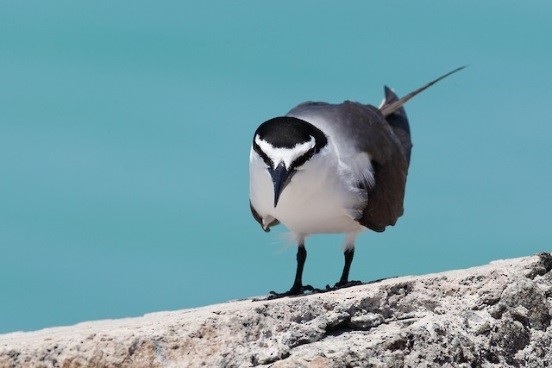
Bridled Tern, O. a. melanoptera, showing its white visor. (Garden Key, Dry Tortugas National Park, Florida; April 22, 2018.) © Geoff Malosh
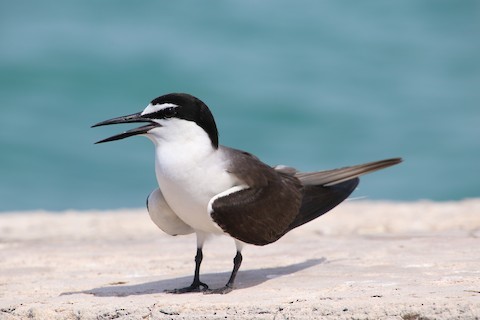
Bridled Tern, O. a. melanopterus. (Garden Key, Dry Tortugas National Park, Florida; July 6, 2019.) © John Groskopf

Bridled Tern, O. a. anaethetus, showing mostly white underwing with blackish leading and trailing edges in the primaries, and narrowly white outer tail feathers. (Penguin Island, Rockingham, Western Australia; December 9, 2012.) © Margot Oorebeek

Bridled Tern, O. a. anaethetus, showing a white collar. (Sai Kung, Hong Kong; July 9, 2020.) © Ryan Yue Wah Chan
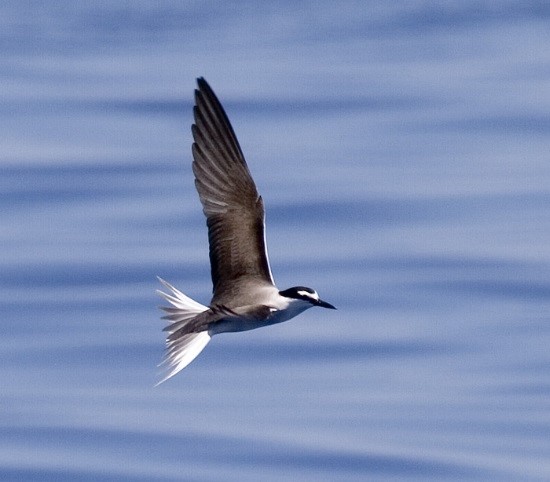
Bridled Tern, O. a. melanopterus, showing extensively white outer tail feathers. (Offshore from Marathon, Florida; June 25, 2005.) © John H. Boyd III

Bridled Tern, O. a. anaethetus. (Ko Tao, Surat Thani, Thailand; July 9, 2019.) © Ayuwat Jearwattanakanok
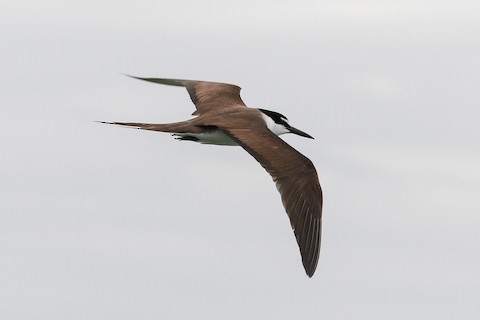
Bridled Tern, O. a. anaethetus. (Penguin Island, Rockingham, Western Australia; February 7, 2017.) © James Kennerley
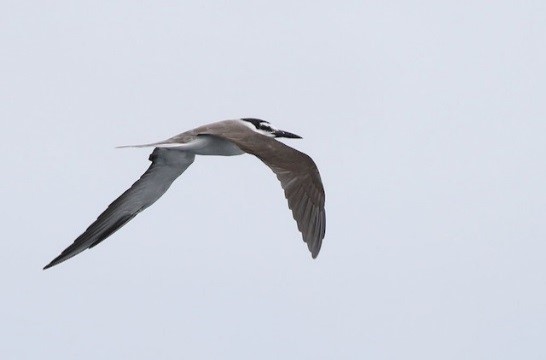
Bridled Tern, O. a. nelsoni. (Offshore from Tropic Star Lodge, Darién, Panama; June 12, 2017.) © William Hull

Bridled Tern, O. a. antarcticus, showing a white collar and fairly extensively white outer tail feathers. (Dalma Island, Abu Dhabi, United Arab Emirates; March 17, 2012.) © Christophe Gouraud
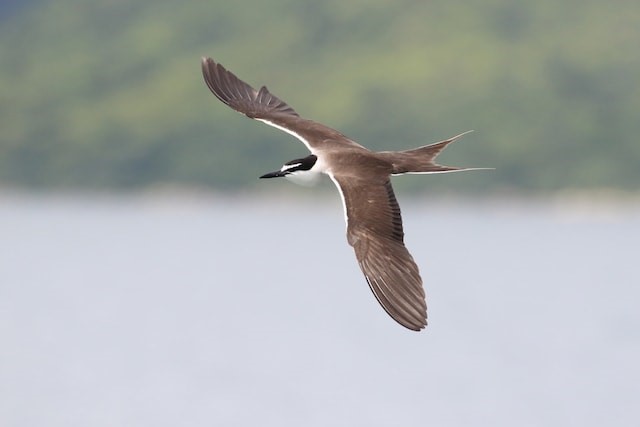
Bridled Tern, O. a. anaethetus, showing a white collar. (Sai Kung, Hong Kong; August 4, 2016.) © Lo Chun Fai
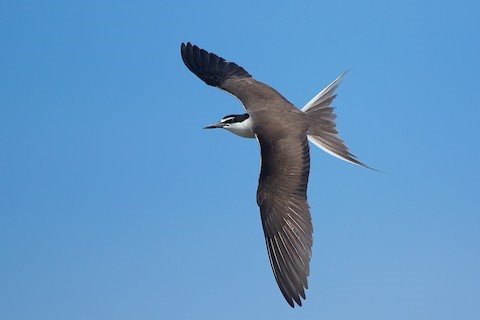
Bridled Tern, O. a. anaethetus. (Ko Tao, Surat Thani, Thailand; July 9, 2019.) © Ayuwat Jearwattanakanok
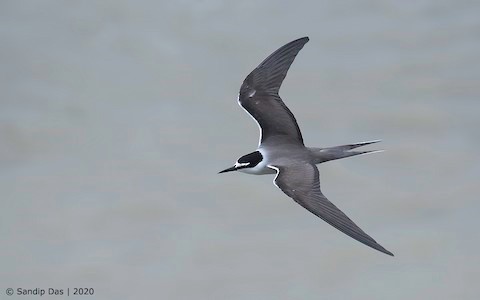
Bridled Tern, O. a. antarcticus, showing a white collar. (North 24 Parganas, West Bengal, India; May 21, 2020.) © Sandip Das
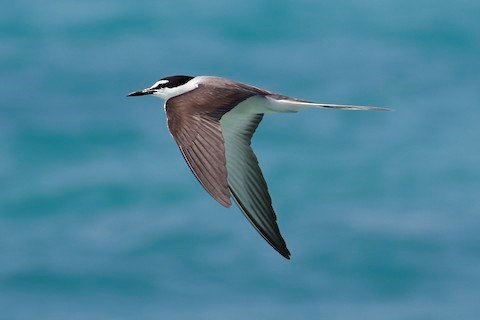
Bridled Tern, O. a. melanopterus. (Garden Key, Dry Tortugas National Park, Florida; May 9, 2019.) © Donna Pomeroy

Bridled Tern, O. a. anaethetus, with prey. (Sai Kung, Hong Kong; July 9, 2020.) © Ryan Yue Wah Chan

Bridled Tern, O. a. anaethetus. (Michaelmas Cay, Queensland, Australia; January 2, 2020.) © J.J. Harrison
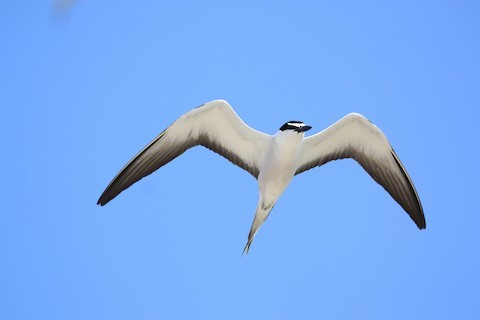
Bridled Tern, O. a. antarcticus, showing extensively white underwing with typically broad blackish trailing edge. (Habitat Island, Abu Dhabi, United Arab Emirates; May 23, 2020.) © Oscar Campbell

Bridled Tern, O. a. anaethetus. (Hong Kong; August 4, 2016.) © Lo Chun Fai

Bridled Tern, O. a. melanopterus. (Offshore from Cape Hatteras, North Carolina; August 13, 2016.) © Knut Hansen

Bridled Tern, O. a. anaethetus. (Sai Kung, Hong Kong; July 9, 2020.) © Ryan Yue Wah Chan
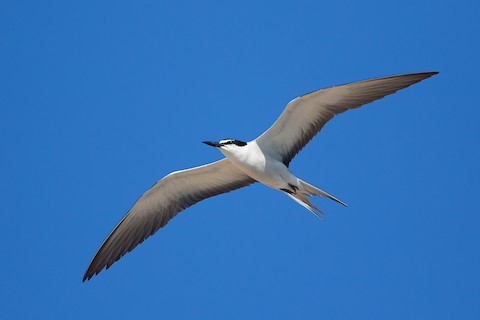
Bridled Tern, O. a. anaethetus. (Ko Tao, Surat Thani, Thailand; July 9, 2019.) © Ayuwat Jearwattanakanok

Bridled Tern, O. a. antarcticus, showing extensively white underwing with typically broad blackish trailing edge. (Taleimannar, Sri Lanka; June 3, 2016.) © Mapalagama K. Premasiri
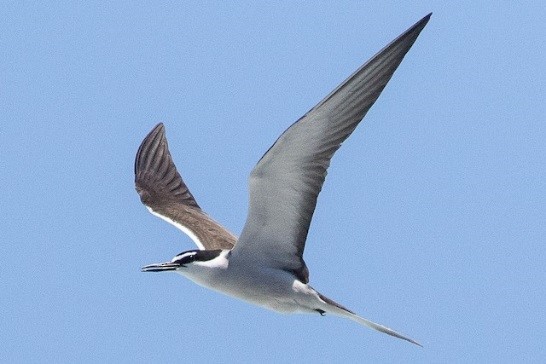
Bridled Tern, O. a. anaethetus. (Aunu’u Island, American Samoa; November 4, 2017.) © Eric VanderWerf
Nonbreeding Plumages. Nonbreeders generally resemble breeding adults, but usually have a mostly white forehead, neck, and upper back, with a smudged, blackish hindcrown or cowl.
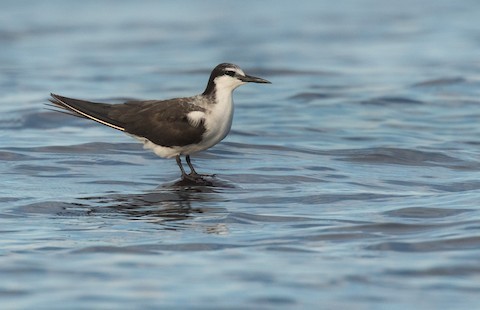
Bridled Tern, O. a. anaethetus. (Wilson Strait, Solomon Islands; July 12, 2015.) © Lars Petersson

Bridled Tern, O. a. melanopterus, nonbreeding. (Offshore from Sanibel Island, Florida; June 21, 2020.) © David McQuade

Bridled Tern, O. a. melanopterus, nonbreeding. (Offshore from Plaquemines Parish, Louisiana; September 2, 2017.) © Bryan White
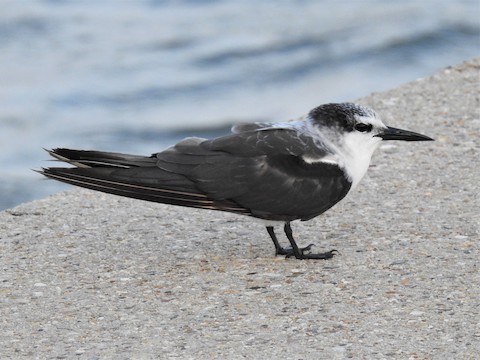
Bridled Tern, O. a. melanopterus, nonbreeding. (Broadwater Marina, Biloxi, Mississippi; June 8, 2020.) © Lucy Jacobson

Bridled Tern, O. a. melanopterus, nonbreeding—likely first-summer based on plumage and date. (Biloxi, Mississippi; June 8, 2017.) © Abby Darrah
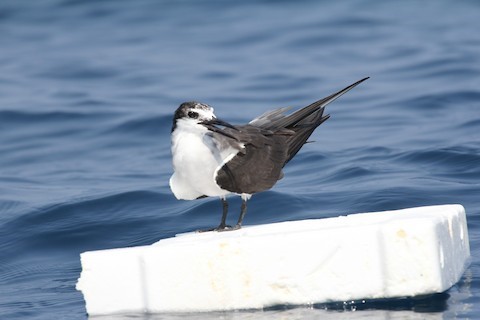
Bridled Tern, O. a. anaethetus, nonbreeding. (Offshore in the Celebes Sea between Maratua and Kalimantan, Indonesia; October 15, 2014.) © Christian Goenner
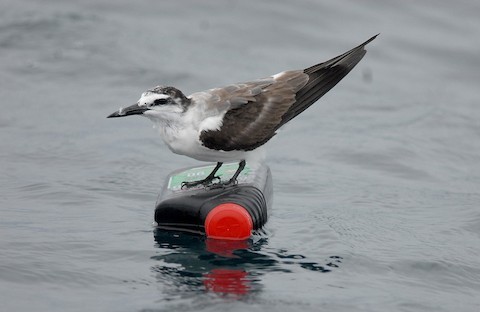
Bridled Tern, O. a. nelsoni, nonbreeding. (Islote Pelado, Santa Elena, Ecuador; August 2, 2009.) © Roger Ahlman
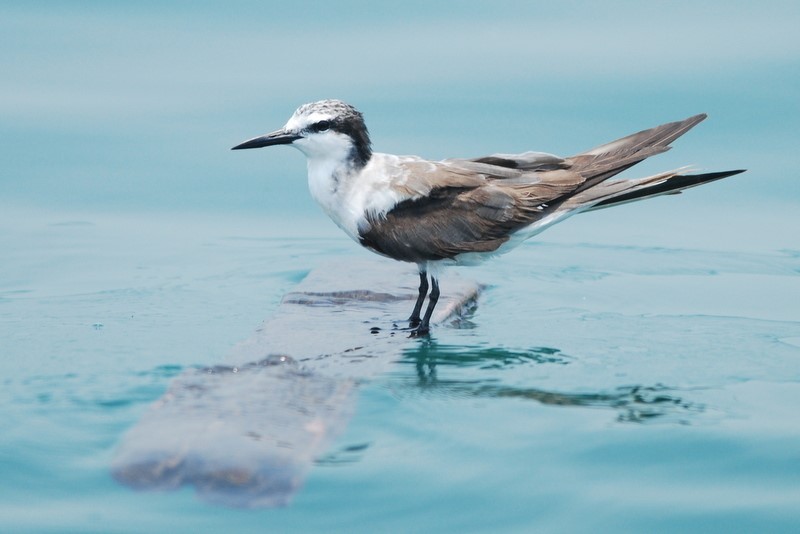
Bridled Tern, O. a. anaethetus, nonbreeding. (Singapore Strait; September 15, 2012.) © Tan Kok Hui
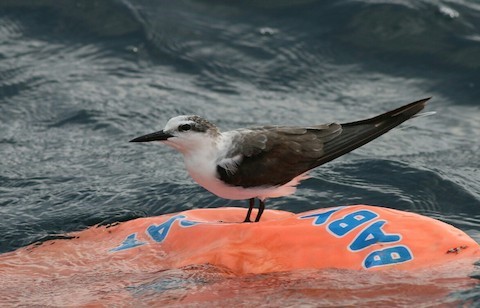
Bridled Tern, O. a. melanopterus, nonbreeding. (Offshore from Cape Hatteras, North Carolina; June 1, 2017.) © Skip Russell

Bridled Tern, O. a. antarcticus, nonbreeding. (Offshore from North Maharashtra, India; October 6, 2013.) © Chinmay Rahane

Bridled Tern, O. a. antarcticus, nonbreeding. (Qurayyat, Masqat, Oman; November 15, 2009.) © Christoph Moning

Bridled Tern, O. a. melanopterus, nonbreeding—likely first-summer based on plumage and date. (Hancock, Mississippi; June 21, 2017.) © June Ladner

Bridled Tern, O. a. melanopterus, nonbreeding—likely first-summer based on plumage and date. (Offshore from Cape Hatteras, North Carolina; June 1, 2019.) © Ryan Sanderson

Bridled Tern, O. a. melanopterus, nonbreeding—likely first-summer based on plumage and date. (Offshore from Cape Hatteras, North Carolina; June 1, 2019.) © Ethan Goodman

Bridled Tern, O. a. melanopterus, nonbreeding. (Offshore from Cape Hatteras, North Carolina; August 7, 2020.) © Eric Zawatski

Bridled Tern, O. a. melanopterus, nonbreeding—likely first-summer based on plumage and date. (Offshore from Naples, Florida; June 22, 2019.) © Tammy McQuade
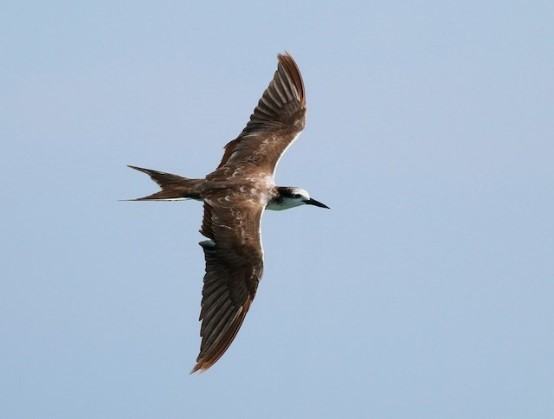
Bridled Tern, O. a. anaethetus, nonbreeding. (Offshore from Tanjung Dawai, Kedah, Malaysia; May 5, 2018.) © Neoh Hor Kee
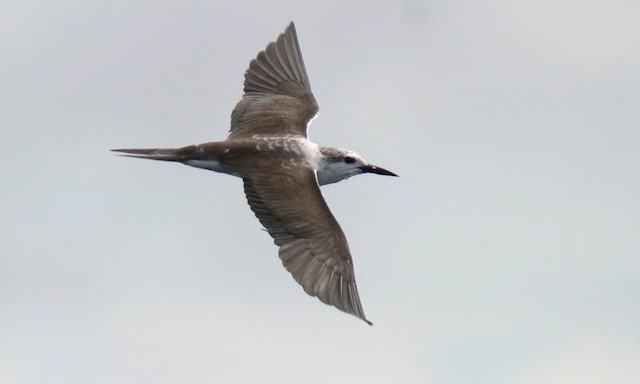
Bridled Tern, O. a. melanopterus, nonbreeding. (Offshore from Oregon Inlet, North Carolina; August 28, 2005.) © Brian Sullivan

Bridled Tern, O. a. anaethetus, nonbreeding. (Offshore from Tanjung Dawai, Kedah, Malaysia; April 30, 2017.) © Neoh Hor Kee
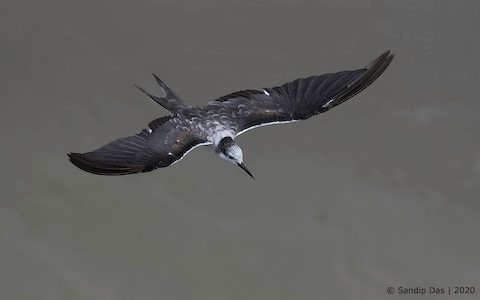
Bridled Tern, O. a. antarcticus, nonbreeding. (North 24 Parganas, West Bengal, India; May 21, 2020.) © Sandip Das

Bridled Tern, O. a. melanopterus, nonbreeding. (Offshore from Plaquemines Parish, Louisiana; September 2, 2017.) © Hal Mitchell

Bridled Tern, O. a. anaethetus, nonbreeding. (Offshore from Tanjung Dawai, Kedah, Malaysia; May 20, 2017.) © Neoh Hor Kee

Bridled Tern, O. a. anaethetus, nonbreeding. (Offshore from Tanjung Dawai, Kedah, Malaysia; May 20, 2017.) © Neoh Hor Kee
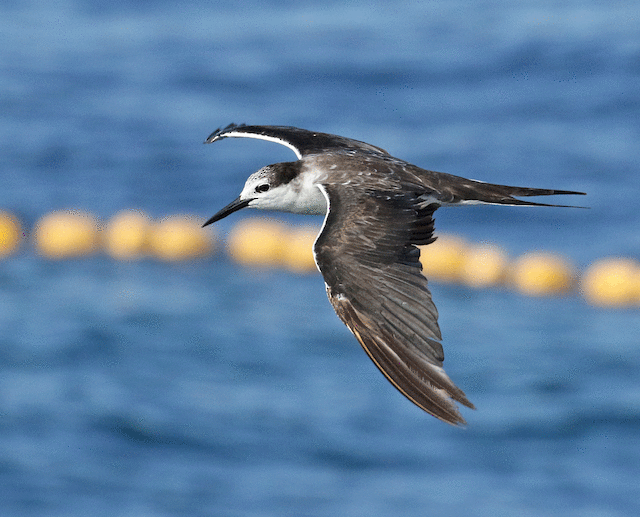
Bridled Tern, O. a. anaethetus, nonbreeding. (Offshore from Tanjung Dawai, Kedah, Malaysia; May 23, 2017.) © Dave Bakewell
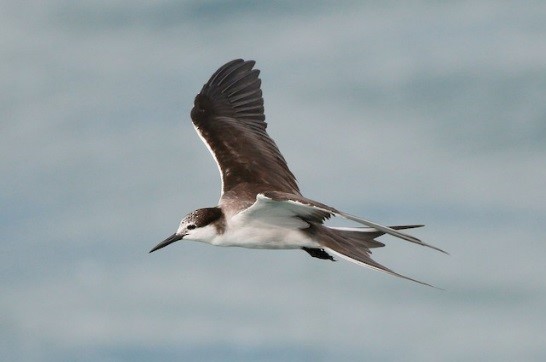
Bridled Tern, O. a. anaethetus, nonbreeding. (Offshore from Tanjung Dawai, Kedah, Malaysia; April 2, 2017.) © Neoh Hor Kee
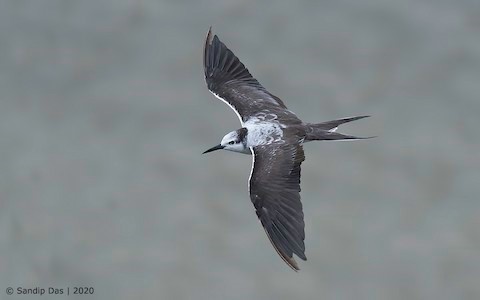
Bridled Tern, O. a. antarcticus, nonbreeding. (North 24 Parganas, West Bengal, India; May 21, 2020.) © Sandip Das
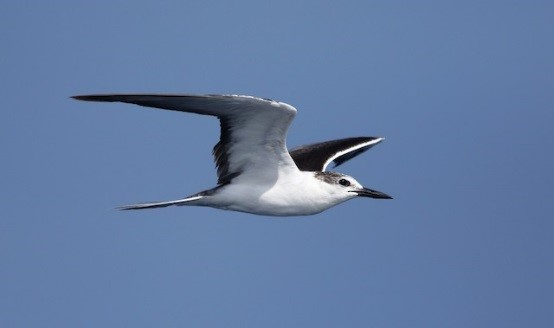
Bridled Tern, O. a. melanopterus, nonbreeding. (Offshore from Cape Hatteras, North Carolina; August 8, 2015.) © Jay McGowan
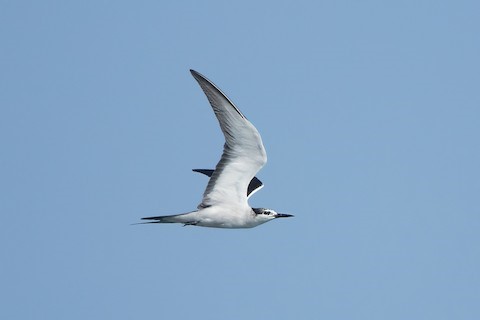
Bridled Tern, O. a. anaethetus, nonbreeding. (Ko Tao, Surat Thani, Thailand; July 9, 2019.) © Ayuwat Jearwattanakanok

Bridled Tern, O. a. anaethetus, nonbreeding. (Offshore from Tanjung Dawai, Kedah, Malaysia; April 30, 2017.) © Neoh Hor Kee
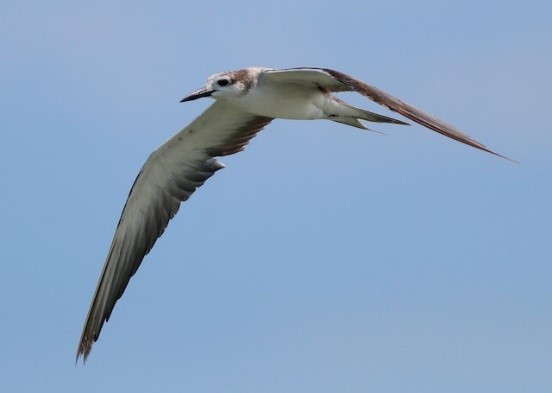
Bridled Tern, O. a. anaethetus, nonbreeding. (Offshore from Tanjung Dawai, Kedah, Malaysia; May 5, 2018.) © Neoh Hor Kee

Bridled Tern, O. a. melanopterus. (Offshore from Cape Hatteras, North Carolina; August 12, 2017.) © Kyle Kittelberger

Bridled Tern, O. a. anaethetus, nonbreeding. (Offshore from Tanjung Dawai, Kedah, Malaysia; April 2, 2017.) © Neoh Hor Kee
Immature Plumages. Juveniles have roughly the same overall plumage pattern as nonbreeding adults, but with fine white or tan fringes on the back and wings.

Bridled Tern, O. a. anaethetus, adult and juvenile, resting on debris. (Carnarvon, Western Australia; March 4, 2018.) © Greg McKay
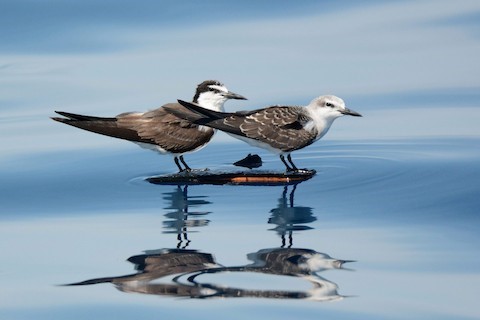
Bridled Tern, O. a. melanopterus, adult and juvenile, resting on driftwood. (Offshore from Cape Hatteras, North Carolina; September 8, 2018.) © Kyle Kittelberger
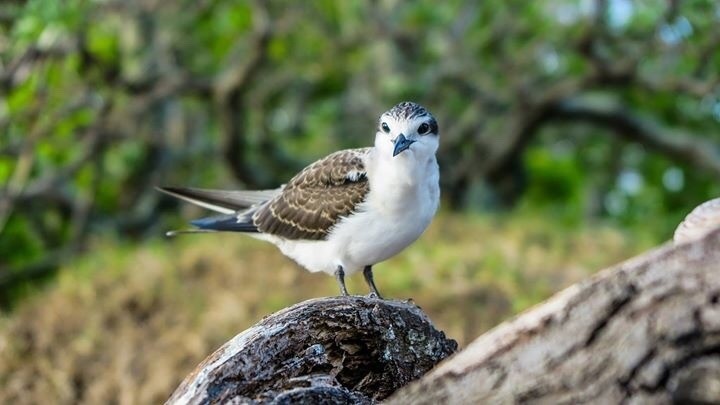
Bridled Tern, O. a. anaethetus, juvenile. (Capricornia Cays National Park, Queensland, Australia; January 29, 2019.) © Emma Kennedy

Bridled Tern, O. a. anaethetus, juvenile. (Lady Musgrave Island, Queensland, Australia; January 9, 2016.) © Andrew Naumann

Bridled Tern, O. a. antarcticus, juvenile. (Adam’s Bridge, Sri Lanka; August 25, 2015.) © Gehan de Silva Wijeyeratne

Bridled Tern, O. a. antarcticus, adult and juvenile, resting driftwood. (Offshore from Nileshwaram, Kerala, India; September 22, 2013.) © Jainy Kuriakose
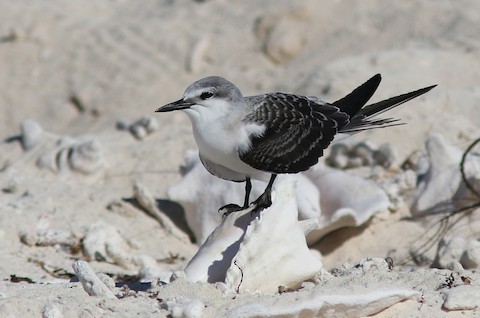
Bridled Tern, O. a. melanopterus, juvenile. (Isla Blanca, Arrecife Alacranes National Park, Yucatán, Mexico; July 30, 2019.) © Amy McAndrews
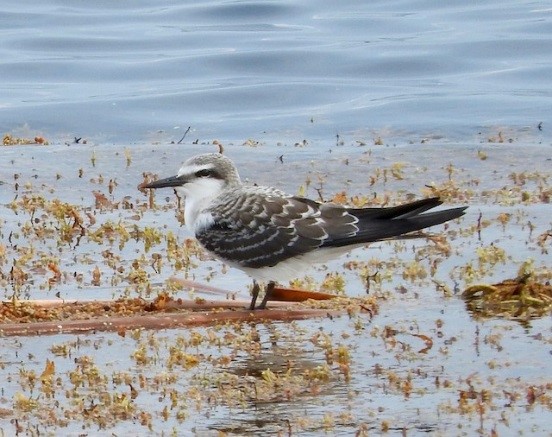
Bridled Tern, O. a. melanopterus, juvenile. (Offshore from Plaquemines Parish, Louisiana; September 6, 2015.) © Van Remsen
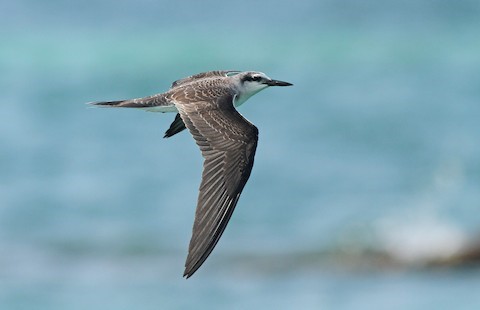
Bridled Tern, O. a. melanopterus, immature. (Isla Grande, Cartagena, Colombia; October 12, 2017.) © Jeremiah Trimble

Bridled Tern, O. a. melanopterus, juvenile. (Offshore from Tybee Island, Georgia; August 23, 2003.) © Bob Zaremba

Bridled Tern, O. a. melanopterus, immature. (Isla Grande, Cartagena, Colombia; October 14, 2017.) © Jeremiah Trimble
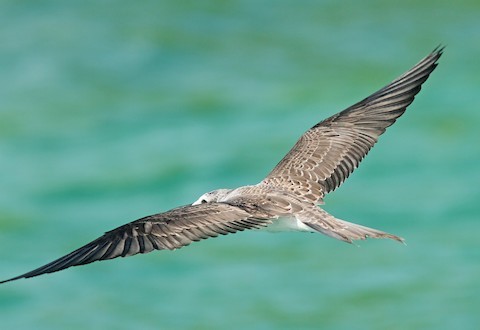
Bridled Tern, O. a. melanopterus, immature. (Isla Grande, Cartagena, Colombia; October 12, 2017.) © Jeremiah Trimble
Cf. Gray-backed Tern. In the western and central Pacific, Bridled and Gray-backed Terns overlap to some extent and can be indistinguishable under some conditions. On average, Gray-backed has much paler-gray upperparts. The difference in shading is usually conspicuous, but individual variation is sufficient to make some cases ambiguous. In particular, some Bridled Terns are pale enough to be misidentified as Gray-backed. A difference that may still be noticeable in such cases is the presence of a paler collar on Bridled—whereas Gray-backed’s gray upperparts typically appear more uniform in tone (under equivalent lighting, posture, etc.).
A more reliable distinction is the pattern of the underwing: Gray-backed’s is almost entirely white with a narrow dark trailing edge, whereas Bridled is mostly white with a broader dark trailing edge and partly dark primaries (especially the outer ones).
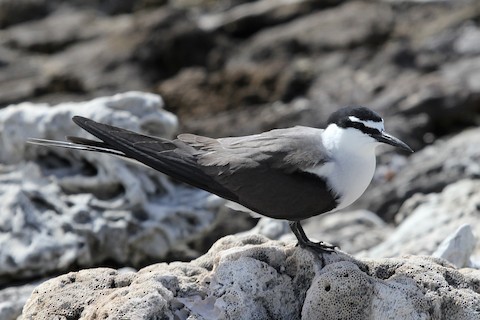
Bridled Tern, O. a. anaethetus. (Leo Island, Houtman Abrolhos Islands, Western Australia; October 14, 2017.) © Ray Turnbull
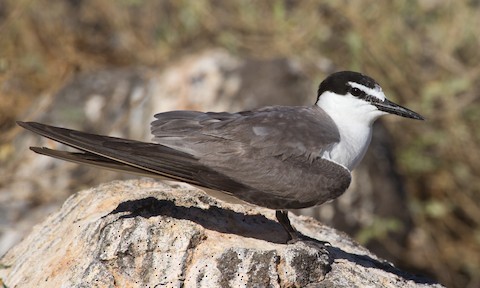
Gray-backed Tern. (Nihoa Island, Hawaii; September 8, 2011.) © Eric VanderWerf
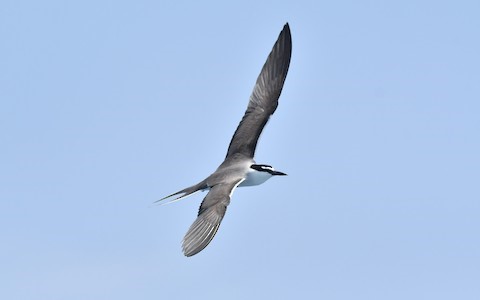
Bridled Tern, O. a. antarcticus. (Offshore from Kochi, Kerala, India; March 25, 2018.) © Aju Raju

Gray-backed Tern. (Laysan Island, Hawaii; January 14, 2012.) © Cameron Rutt
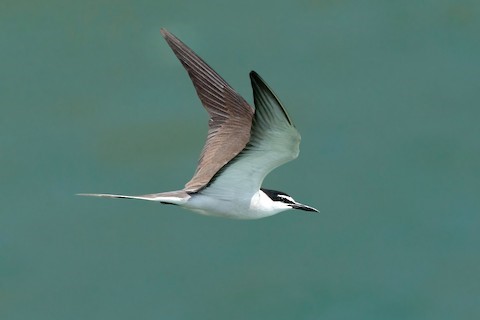
Bridled Tern, O. a. anaethetus. (Xiju Island, Lienchiang County, Taiwan; June 25, 2015.) © David Irving

Gray-backed Tern. (Spit Island, Midway Atoll National Wildlife Refuge, Hawaii; April 17, 2020.) © Will Kennerley
Cf. Sooty Tern. Sooty and Bridled Terns occur together in all of the tropical oceans, and are more similar than many illustrations suggest. In general, Sooty Tern has mostly uniform blackish upperparts, whereas Bridled has a black cap and gray back. However, both have enough internal variation that some individuals of one species could pass for the other. When the neck is not extended, some dark Bridled can appear to have all-black upperparts like a typical Sooty, and the palest Sooties have a black cap, a dark-gray back, and a whitish collar—just like a typical Bridled.
Finally, when seen in flight, the underwing pattern is usually reliable. On Sooty the undersides of all the flight feathers usually appear blackish throughout, whereas Bridled has a blackish trailing edge and outer primaries, but the rest of the primaries are either whitish or gray or mixed, and rarely appear all-blackish.
The most consistent difference is the shape of the white patch on the forehead. Sooty’s white patch fully covers the forehead and ends just above the eye or slightly behind it, whereas Bridled has a thin white “visor” with white brow-stripes that extend well past the eyes. More specifically, on Sooty the boundary between the white forehead patch and black eyestripe is angled such that the eyestripe is narrow at the bill, then broadens around the eye and the white patch narrows to a point above the eye, whereas Bridled’s eyestripe is essentially uniform in width.
Notes
Polytypic species consisting of four to six recognized subspecies.
Howell and Zufelt (2019) provisionally split the subspecies into two “cryptic” species: “Western Bridled Tern” (melanopterus and nelsoni) and “Eastern Bridled Tern” (anaethetus and antarcticus), but the basis for this (or any) division is not self-evident. All subspecies of Bridled Tern are similar to one another and vary internally such that the internal variation seems to swamp the distinctions, so the existence of recognizably distinct forms is questionable.
References
Alderfer, J., and J.L. Dunn. 2014. National Geographic Complete Birds of North America. National Geographic Society, Washington, D.C.
Ascanio, D., G.A. Rodriguez, and R. Restall. 2017. Birds of Venezuela. Christopher Helm, London.
BirdLife International. 2019. Onychoprion anaethetus. The IUCN Red List of Threatened Species 2019: e.T22694730A154676367. https://dx.doi.org/10.2305/IUCN.UK.2019-3.RLTS.T22694730A154676367.en. (Accessed November 25, 2020.)
Brazil, M. 2009. Birds of East Asia. Princeton University Press.
eBird. 2020. eBird: An online database of bird distribution and abundance. Cornell Lab of Ornithology, Ithaca, N.Y. http://www.ebird.org. (Accessed November 25, 2020.)
Fagan, J., and O. Komar. 2016. Peterson Field Guide to the Birds of Northern Central America. Houghton Mifflin Harcourt, New York.
ffrench, R. 2012. A Guide to the Birds of Trinidad & Tobago (Third Edition). Cornell University Press.
Garcia-del-Rey, E. 2011. Field Guide to the Birds of Macaronesia: Azores, Madeira, Canary Islands, Cape Verde. Lynx Editions, Barcelona.
Garrigues, R., and R. Dean. 2014. The Birds of Costa Rica: A Field Guide (Second Edition). Cornell University Press.
Harrison, P. 1983. Seabirds: An Identification Guide. Houghton Mifflin, Boston.
Hollom, P.A.D., R.F. Porter, S. Christensen, and I. Willis. 1988. Birds of the Middle East and North Africa. T & AD Poyser, Calton, England.
Howell, S.N.G. and S.W. Webb. 1995. A Guide to the Birds of Mexico and Northern Central America. Oxford University Press, Oxford.
Howell, S.N.G., and K. Zufelt. 2019. Oceanic Birds of the World. Princeton University Press.
Kirwan, G.M., A. Levesque, M. Oberle, and C.J. Sharpe. 2019. Birds of the West Indies. Lynx Edicions, Barcelona.
Lee, D.S., and W.A. Mackin. 2009. Bridled Tern. West Indian Breeding Seabird Atlas, http://www.wicbirds.net/brte.html. (Accessed May 19, 2018.)
McMullan, M., and T. Donegan. 2014, Field Guide to the Birds of Colombia (Second Edition). Fundación Proaves de Colombia, Bogotá.
Pyle, R.L., and P. Pyle. 2017. The Birds of the Hawaiian Islands: Occurrence, History, Distribution, and Status. Version 2 (January 1, 2017). http://hbs.bishopmuseum.org/birds/rlp-monograph/. B.P. Bishop Museum, Honolulu, Hawaii.
Raffaele, H., J. Wiley, O. Garrido, A. Keith, and J. Raffaele. 1998. A Guide to the Birds of the West Indies. Princeton University Press.
Ridgely, R.S., and P.J. Greenfield. 2001. The Birds of Ecuador: Field Guide. Cornell University Press, Ithaca, N.Y.
Ridgely, R.S., and J.A. Gwynne. 1989. A Guide to the Birds of Panama (Second Edition). Princeton University Press.
Robson, C. 2002. Birds of Thailand. Princeton University Press.
Sibley, D.A. 2000. The Sibley Guide to Birds. Alfred A. Knopf. New York.
Sinclair, I., P. Hockey, W. Tarboton, and P. Ryan. 2011. Birds of Southern Africa (Fourth Edition). Random House Struik (Pty) Ltd. Cape Town, South Africa.
van Perlo, B. 2002. Birds of Western and Central Africa. Princeton University Press, Princeton, N.J.
Wells, J.V., and A.C. Wells. 2017. Birds of Aruba, Bonaire, and Curaçao. Cornell University Press.
Xeno-Canto. 2020. Bridled Tern – Onychoprion anaethetus. https://www.xeno-canto.org/species/Onychoprion-anaethetus. (Accessed November 25, 2020.)

